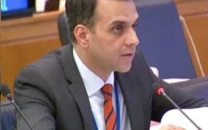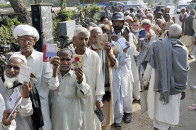RCC conference: Regional countries need to invest more for disaster proofing
Experts say not spending on risk mitigation increases response cost

The participants agreed that disasters are not isolated events and that no country can mitigate the cause of natural hazards alone as a disaster in one country disrupts the lives of those living far away. PHOTO: APP
This concern was voiced in Islamabad on the second day of the three-day 13th annual Regional Consultative Committee (RCC) on disaster management.
Reviewing data from disasters, the committee called for more investment in flood protection, earthquake resilience, drought mitigation, food security, agriculture, climate change adaptation, and water and ecosystem conservation.
Experts cautioned that by not spending enough on disaster risk reduction (DRR) measures, the cost of providing humanitarian relief to disaster victims and survivors increases further.

They discussed the challenges and options for implementing global frameworks including the Paris Agreement on Climate Change, Sustainable Development Goals, and the Sendai Framework for DRR. They identified that creating linkages between these frameworks was not an easy task and that some concerted efforts were needed to overcome the challenge, drawing commonalities and adopting a focused approach.
They referred to the World Disaster Report 2016, which showed that up to two-thirds of total international aid expenditure was devoted to emergencies, with little invested in risk reduction.
National Disaster Management Authority (NDMA) Chairman Major-General Asghar Nawaz recommended that a comprehensive monitoring tool must be developed which countries could use at macro level for the effective monitoring and implementation of the three frameworks.
Asian Disaster Preparedness Centre (ADPC) Thailand Director Dr Peeranan Towashiraporn said countries needed to enhance their risk assessment and information management mechanisms, given that the region was highly prone to disasters.
“More than 5,000 disasters have hit this region since 1970, which killed over two billion people and affected the lives of six billion others,” he said.
“In the recent past, the Indian Ocean Tsunami claimed the lives of 230,000 people in 14 countries in 2004. The 2005 Kashmir earthquake killed over 74,000 people in Pakistan in 2005, and Cyclone Nargis killed 138,000 people in Myanmar in 2008,” Dr Towashiraporn stated.
He urged the committee to learn lessons from disasters in this region to develop a mechanism to prevent losses from such disasters in the future.
Even though most Asian countries have disaster-risk reduction policies and plans, funding was often not available to avoid emergencies.
The participants agreed that disasters are not isolated events and that no country can mitigate the cause of natural hazards alone as a disaster in one country disrupts the lives of those living far away.
Regional mechanism of cooperation such as South Asian Association for Regional Cooperation (SAARC), Association of Southeast Asian Nations (ASEAN), Heart of Asia, Regional Consultative Committee and other formal and informal forums are critical to facilitate the implementation of disaster reduction and climate change adaptation-related global frameworks.
Published in The Express Tribune, October 19th, 2016.



1724926799-0/Untitled-design-(7)1724926799-0-208x130.webp)















COMMENTS
Comments are moderated and generally will be posted if they are on-topic and not abusive.
For more information, please see our Comments FAQ